View Other Topics
Walpurgis Night
Apr 30, 2017
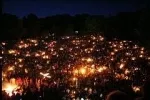 Walpurgis Night, according to Wikipedia, is the English translation of Walpurgisnacht [valˈpʊʁɡɪsˌnaχt], one of the Dutch and German names for the night of 30 April, so called because it is the eve of the feast day of Saint Walpurga, an 8th-century abbess in Francia. In Germanic folklore, Walpurgisnacht, also called Hexennacht (Dutch: heksennacht), literally "Witches' Night", is believed to be the night of a witches' meeting on the Brocken, the highest peak in the Harz Mountains, a range of wooded hills in central Germany between the rivers Weser and Elbe. The first known written occurrence of the English translation "Walpurgis Night" is from the 19th century. Local variants of Walpurgis Night are observed throughout Europe in the Netherlands, Germany, the Czech Republic, Slovenia, Sweden, Lithuania, Latvia, Finland, and Estonia. In Denmark the tradition with bonfires to fence of the witches going to the Brocken is observed as Saint John's Eve - essentially a midsummer celebration "with witches".
Walpurgis Night, according to Wikipedia, is the English translation of Walpurgisnacht [valˈpʊʁɡɪsˌnaχt], one of the Dutch and German names for the night of 30 April, so called because it is the eve of the feast day of Saint Walpurga, an 8th-century abbess in Francia. In Germanic folklore, Walpurgisnacht, also called Hexennacht (Dutch: heksennacht), literally "Witches' Night", is believed to be the night of a witches' meeting on the Brocken, the highest peak in the Harz Mountains, a range of wooded hills in central Germany between the rivers Weser and Elbe. The first known written occurrence of the English translation "Walpurgis Night" is from the 19th century. Local variants of Walpurgis Night are observed throughout Europe in the Netherlands, Germany, the Czech Republic, Slovenia, Sweden, Lithuania, Latvia, Finland, and Estonia. In Denmark the tradition with bonfires to fence of the witches going to the Brocken is observed as Saint John's Eve - essentially a midsummer celebration "with witches".
The current festival is, in most countries that celebrate it, named after the English missionary Saint Walpurga (c. 710–777/9). As Walpurga's feast was held on 1 May (c. 870), she became associated with May Day, especially in the Finnish and Swedish calendars. The eve of May Day, traditionally celebrated with dancing, came to be known as Walpurgisnacht ("Walpurga's night"). The name of the holiday is Walpurgisnacht or Hexennacht ("Witches' Night") in German, Heksennacht in Dutch, Valborgsmässoafton in Swedish, Vappen in Finland Swedish, Vappu in Finnish, Volbriöö in Estonian, Valpurgijos naktis in Lithuanian, Valpurģu nakts or Valpurģi in Latvian, čarodějnice and Valpuržina noc in Czech.
The Germanic term Walpurgisnacht is recorded in 1668 by Johannes Praetorius as S. Walpurgis Nacht or S. Walpurgis Abend. An earlier mention of Walpurgis and S. Walpurgis Abend is in the 1603 edition of the Calendarium perpetuum of Johann Coler, who also refers to the following day, 1 May, as Jacobi Philippi, feast day of the apostles James the Less and Philip in the Catholic calendar.
The 17th-century German tradition of a meeting of sorcerers and witches on May Day eve (Hexennacht, "Witches' Night") is influenced by the descriptions of Witches' Sabbaths in 15th- and 16th-century literature.
Regional variations
Czech Republic
30 April is pálení čarodějnic ("burning of the witches") or čarodějnice ("the witches") in the Czech Republic. Huge bonfires—up to 8 metres (26 ft) tall—are built and burnt in the evening, preferably on top of hills. Young people gather around. Sudden black and dense smoke formations are cheered as "a witch flying away". As evening advances to midnight and fire is on the wane, it is time to go search for a cherry tree in blossom. Young women should be kissed past midnight (and during the following day) under a cherry tree. They "will not dry up" for an entire year. The First of May is celebrated then as "the day of those in love".
Estonia
In Estonia, Volbriöö is celebrated throughout the night of 30 April and into the early hours of 1 May, where 1 May is a public holiday called "Spring Day" (Kevadpüha). Volbriöö is an important and widespread celebration of the arrival of spring in the country. Influenced by German culture, the night originally stood for the gathering and meeting of witches. Modern people still dress up as witches to wander the streets in a carnival-like mood.
The Volbriöö celebrations are especially vigorous in Tartu, the university town in southern Estonia. For Estonian students in student corporations (fraternities and sororities), the night starts with a traditional procession through the streets of Tartu, followed by visiting each other's corporation houses throughout the night.
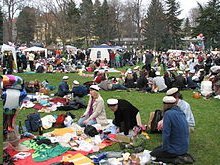
People at a Vappu picnic in Kaivopuisto in 2008 - Wikipedia
Germany
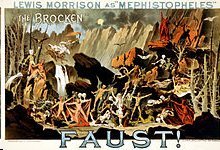
Lewis Morrison as "Mephistopheles" in Faust!: "The Brocken". Poster for a theatrical performance of Goethe's play showing Mephistopheles conjuring supernatural creatures on the German mountain, the Brocken (or Blocksberg), which according to the tale is the scenery for the Walpurgisnight, from 30 April to 1 May. - Wikipedia
Lewis Morrison as "Mephistopheles" in Faust!: "The Brocken". Poster for a theatrical performance of Goethe's play showing Mephistopheles conjuring supernatural creatures on the German mountain, the Brocken (or Blocksberg), which according to the tale is the scenery for the Walpurgisnight, from 30 April to 1 May.
In Germany, Walpurgisnacht or Hexennacht ("Witches' Night"), the night from 30 April to 1 May, is the night when witches are reputed to hold a large celebration on the Brocken and await the arrival of spring.
Walpurgisnacht Night (in German folklore) the night of 30 April (May Day's eve), when witches meet on the Brocken mountain and hold revels with the Devil...
Brocken is the highest of the Harz Mountains of north central Germany. It is noted for the phenomenon of the Brocken spectre and for witches' revels which reputedly took place there on Walpurgis night.
The Brocken Spectre is a magnified shadow of an observer, typically surrounded by rainbow-like bands, thrown onto a bank of cloud in high mountain areas when the sun is low. The phenomenon was first reported on the Brocken.
A scene in Goethe's Faust Part One is called "Walpurgisnacht," and one in Faust Part Two is called "Classical Walpurgisnacht." The last chapter of book five in Thomas Mann's The Magic Mountain is also called "Walpurgisnacht." In Edward Albee's 1962 play Who's Afraid of Virginia Woolf?, Act Two is entitled "Walpurgisnacht."
From Bram Stoker's short story, "Dracula's Guest," an Englishman (whose name is never mentioned) is on a visit to Munich before leaving for Transylvania. It is Walpurgis Night, and in spite of the hotelier's warning not to be late coming back, the young man later leaves his carriage and wanders toward the direction of an abandoned "unholy" village. As the carriage departs with the frightened and superstitious driver, a tall and thin stranger scares the horses at the crest of a hill.
In some parts of northern coastal regions of Germany, the custom of lighting huge fires is still kept alive to celebrate the coming of May, while most parts of Germany have a derived Christianized custom around Easter called "Easter fires" (Osterfeuer).
In rural parts of southern Germany, it is part of popular youth culture to play pranks such as tampering with neighbours' gardens, hiding possessions, or spraying graffiti on private property.
In Berlin, traditional leftist May Day riots usually start at Walpurgis Night in the Mauerpark in Prenzlauer Berg. There is a similar tradition in the Schanzenviertel district of Hamburg, though in both cases, the situation has significantly calmed down in the past few years.
Sweden
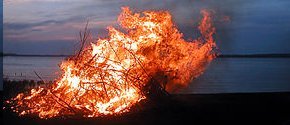
Walpurgis Night bonfire in Sweden- Wikipedia
While the name Walpurgis is taken from the eighth-century English missionary Saint Walburga, Valborg, as it is called in Swedish, has very little to do with religion and everything to do with the arrival of spring. The forms of celebration vary in different parts of the country and between different cities. Walpurgis celebrations are not a family occasion but rather a public event, and local groups often take responsibility for organising them to encourage community spirit in the village or neighbourhood.
In the Middle Ages, the administrative year ended on 30 April. Accordingly, this was a day of festivity among the merchants and craftsmen of the town, with trick-or-treat, dancing and singing in preparation for the forthcoming celebration of spring. Sir James George Frazer in The Golden Bough writes, "The first of May is a great popular festival in the more midland and southern parts of Sweden. On the eve of the festival, huge bonfires, which should be lighted by striking two flints together, blaze on all the hills and knolls."
Walpurgis bonfires are part of a Swedish tradition dating back to the early 18th century. At Walpurgis (Valborg), farm animals were let out to graze and bonfires (majbrasor, kasar) lit to scare away predators. In Southern Sweden, an older tradition, no longer practiced, was for the younger people to collect greenery and branches from the woods at twilight. These were used to adorn the houses of the village. The expected reward for this task was to be paid in eggs.
A large crowd, mostly students in typical Swedish white student caps, participating in the traditional Walpurgis Night celebration with song outside the Castle in Uppsala. The silhouette of the cathedral towers may be seen in the background. To the right are banners and standards of the student nations. Image from c. 1920.
Choral singing is a popular pastime in Sweden, and on Walpurgis Eve virtually every choir in the country is busy. Singing traditional songs of spring is widespread throughout the country. The songs are mostly from the 19th century and were spread by students' spring festivities. The strongest and most traditional spring festivities are also found in the old university cities, such as Uppsala and Lund, where undergraduates, graduates, and alumni gather at events that last most of the day from early morning to late night on April 30, or siste april ("The Last Day of April") as it is called in Lund, or sista april as it is called in Uppsala. For students, Walpurgis Eve heralds freedom. Traditionally the exams were over and only the odd lecture remained before term ends. On the last day of April, the students don their characteristic white caps and sing songs of welcome to spring, to the budding greenery and to a brighter future.
More modern Valborg celebrations, particularly among Uppsala students, often consist of enjoying a breakfast including champagne and strawberries. During the day, people gather in parks, drink considerable amounts of alcoholic beverages, barbecue, and generally enjoy the weather, if it happens to be favorable.
In Uppsala, since 1975, students honor spring by rafting on Fyrisån through the center of town with rickety, homemade, in fact quite easily wreckable, and often humorously decorated rafts. Several nations also hold "Champagne Races" (Swedish: Champagnegalopp), where students go to drink and spray champagne or somewhat more modestly priced sparkling wine on each other. The walls and floors of the old nation buildings are covered in plastic for this occasion, as the champagne is poured around recklessly and sometimes spilled enough to wade in. Spraying champagne is, however, a fairly recent addition to the Champagne Race. The name derives from the students running down the downhill slope from the Carolina Rediviva library, toward the Student Nations, to drink champagne.
In Linköping many students and former students begin the day at the park Trädgårdföreningen, in the field below Belvederen where the city laws permits alcohol, to drink champagne breakfast in a similar way to Uppsala. Later at 15:00 o'clock the students and public gather at the courtyard of Linköping Castle. Spring songs are sung by the Linköping University Male Voice Choir, and speeches are made by representatives of the students and the university professors.
In Gothenburg, the carnival parade, The Cortège, which has been held since 1909 by the students at Chalmers University of Technology, is an important part of the celebration. It is seen by around 250,000 people each year. Another major event is the gathering of students in Trädgårdsföreningen to listen to student choirs, orchestras, and speeches. An important part of the gathering is the ceremonial donning of the student cap, which stems from the time when students wore their caps daily and switched from black winter cap to white summer cap.
In Umeå, there is a tradition of having local bonfires. During recent years, however, there has been a tradition of celebrating Walpurgis at the Umeå University campus. The university organizes student choir songs, there are different types of entertainment and a speech by the president of the university. Different stalls sell hot dogs, candies, soft drinks, etc.
Netherlands
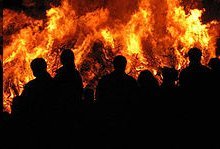
Walpurgis night bonfires - Wikipedia
As in all Germanic countries, Walpurgisnacht was celebrated in areas of what is now the Netherlands. It is not celebrated today due to the national Koninginnedag falling on the same date, though the new koningsdag (king's day) is on 27 April. The island of Texel celebrates a festival known as the 'Meierblis (nl)' (roughly translated as 'May-Blaze') on that same day, where bonfires are lit near nightfall, just as on Walpurgis. But with the meaning to drive away the remaining cold of winter and welcome spring. Occasional mentions to the ritual occur, and at least once a feminist group co-opted the name to call for attention to the position of women (following the example of German women's organizations), a variety of the Take Back the Night phenomenon.
Still, in recent years a renewed interest in pre-Christian religion and culture has led to renewed interest in Walpurgis Night as well. In 1999, suspicions were raised among local Reformed party members in Putten, Gelderland of a Walpurgis festival celebrated by Satanists. The party called for a ban. Whether such a festival even existed, however, and whether it was 'Satanic', was doubted by others. Rumors that Satanic sects celebrate Walpurgis Night come from other towns as well, with the local churches in Dokkum, Friesland organizing a service in 2003 to pray to the Holy Spirit to counter such Satanic action.
Additional image: Walpurgisnacht at the open-air theatre inHeidelberg - Wikipedia
Tags:
#walpurgis#night,#feast#day,#ssaint#walpurgis,#festival,#starzpsychics.com,#starz#advisors

The current festival is, in most countries that celebrate it, named after the English missionary Saint Walpurga (c. 710–777/9). As Walpurga's feast was held on 1 May (c. 870), she became associated with May Day, especially in the Finnish and Swedish calendars. The eve of May Day, traditionally celebrated with dancing, came to be known as Walpurgisnacht ("Walpurga's night"). The name of the holiday is Walpurgisnacht or Hexennacht ("Witches' Night") in German, Heksennacht in Dutch, Valborgsmässoafton in Swedish, Vappen in Finland Swedish, Vappu in Finnish, Volbriöö in Estonian, Valpurgijos naktis in Lithuanian, Valpurģu nakts or Valpurģi in Latvian, čarodějnice and Valpuržina noc in Czech.
The Germanic term Walpurgisnacht is recorded in 1668 by Johannes Praetorius as S. Walpurgis Nacht or S. Walpurgis Abend. An earlier mention of Walpurgis and S. Walpurgis Abend is in the 1603 edition of the Calendarium perpetuum of Johann Coler, who also refers to the following day, 1 May, as Jacobi Philippi, feast day of the apostles James the Less and Philip in the Catholic calendar.
The 17th-century German tradition of a meeting of sorcerers and witches on May Day eve (Hexennacht, "Witches' Night") is influenced by the descriptions of Witches' Sabbaths in 15th- and 16th-century literature.
Regional variations
Czech Republic
30 April is pálení čarodějnic ("burning of the witches") or čarodějnice ("the witches") in the Czech Republic. Huge bonfires—up to 8 metres (26 ft) tall—are built and burnt in the evening, preferably on top of hills. Young people gather around. Sudden black and dense smoke formations are cheered as "a witch flying away". As evening advances to midnight and fire is on the wane, it is time to go search for a cherry tree in blossom. Young women should be kissed past midnight (and during the following day) under a cherry tree. They "will not dry up" for an entire year. The First of May is celebrated then as "the day of those in love".
Estonia
In Estonia, Volbriöö is celebrated throughout the night of 30 April and into the early hours of 1 May, where 1 May is a public holiday called "Spring Day" (Kevadpüha). Volbriöö is an important and widespread celebration of the arrival of spring in the country. Influenced by German culture, the night originally stood for the gathering and meeting of witches. Modern people still dress up as witches to wander the streets in a carnival-like mood.
The Volbriöö celebrations are especially vigorous in Tartu, the university town in southern Estonia. For Estonian students in student corporations (fraternities and sororities), the night starts with a traditional procession through the streets of Tartu, followed by visiting each other's corporation houses throughout the night.

People at a Vappu picnic in Kaivopuisto in 2008 - Wikipedia
Germany

Lewis Morrison as "Mephistopheles" in Faust!: "The Brocken". Poster for a theatrical performance of Goethe's play showing Mephistopheles conjuring supernatural creatures on the German mountain, the Brocken (or Blocksberg), which according to the tale is the scenery for the Walpurgisnight, from 30 April to 1 May. - Wikipedia
Lewis Morrison as "Mephistopheles" in Faust!: "The Brocken". Poster for a theatrical performance of Goethe's play showing Mephistopheles conjuring supernatural creatures on the German mountain, the Brocken (or Blocksberg), which according to the tale is the scenery for the Walpurgisnight, from 30 April to 1 May.
In Germany, Walpurgisnacht or Hexennacht ("Witches' Night"), the night from 30 April to 1 May, is the night when witches are reputed to hold a large celebration on the Brocken and await the arrival of spring.
Walpurgisnacht Night (in German folklore) the night of 30 April (May Day's eve), when witches meet on the Brocken mountain and hold revels with the Devil...
Brocken is the highest of the Harz Mountains of north central Germany. It is noted for the phenomenon of the Brocken spectre and for witches' revels which reputedly took place there on Walpurgis night.
The Brocken Spectre is a magnified shadow of an observer, typically surrounded by rainbow-like bands, thrown onto a bank of cloud in high mountain areas when the sun is low. The phenomenon was first reported on the Brocken.
A scene in Goethe's Faust Part One is called "Walpurgisnacht," and one in Faust Part Two is called "Classical Walpurgisnacht." The last chapter of book five in Thomas Mann's The Magic Mountain is also called "Walpurgisnacht." In Edward Albee's 1962 play Who's Afraid of Virginia Woolf?, Act Two is entitled "Walpurgisnacht."
From Bram Stoker's short story, "Dracula's Guest," an Englishman (whose name is never mentioned) is on a visit to Munich before leaving for Transylvania. It is Walpurgis Night, and in spite of the hotelier's warning not to be late coming back, the young man later leaves his carriage and wanders toward the direction of an abandoned "unholy" village. As the carriage departs with the frightened and superstitious driver, a tall and thin stranger scares the horses at the crest of a hill.
In some parts of northern coastal regions of Germany, the custom of lighting huge fires is still kept alive to celebrate the coming of May, while most parts of Germany have a derived Christianized custom around Easter called "Easter fires" (Osterfeuer).
In rural parts of southern Germany, it is part of popular youth culture to play pranks such as tampering with neighbours' gardens, hiding possessions, or spraying graffiti on private property.
In Berlin, traditional leftist May Day riots usually start at Walpurgis Night in the Mauerpark in Prenzlauer Berg. There is a similar tradition in the Schanzenviertel district of Hamburg, though in both cases, the situation has significantly calmed down in the past few years.
Sweden

Walpurgis Night bonfire in Sweden- Wikipedia
While the name Walpurgis is taken from the eighth-century English missionary Saint Walburga, Valborg, as it is called in Swedish, has very little to do with religion and everything to do with the arrival of spring. The forms of celebration vary in different parts of the country and between different cities. Walpurgis celebrations are not a family occasion but rather a public event, and local groups often take responsibility for organising them to encourage community spirit in the village or neighbourhood.
In the Middle Ages, the administrative year ended on 30 April. Accordingly, this was a day of festivity among the merchants and craftsmen of the town, with trick-or-treat, dancing and singing in preparation for the forthcoming celebration of spring. Sir James George Frazer in The Golden Bough writes, "The first of May is a great popular festival in the more midland and southern parts of Sweden. On the eve of the festival, huge bonfires, which should be lighted by striking two flints together, blaze on all the hills and knolls."
Walpurgis bonfires are part of a Swedish tradition dating back to the early 18th century. At Walpurgis (Valborg), farm animals were let out to graze and bonfires (majbrasor, kasar) lit to scare away predators. In Southern Sweden, an older tradition, no longer practiced, was for the younger people to collect greenery and branches from the woods at twilight. These were used to adorn the houses of the village. The expected reward for this task was to be paid in eggs.
A large crowd, mostly students in typical Swedish white student caps, participating in the traditional Walpurgis Night celebration with song outside the Castle in Uppsala. The silhouette of the cathedral towers may be seen in the background. To the right are banners and standards of the student nations. Image from c. 1920.
Choral singing is a popular pastime in Sweden, and on Walpurgis Eve virtually every choir in the country is busy. Singing traditional songs of spring is widespread throughout the country. The songs are mostly from the 19th century and were spread by students' spring festivities. The strongest and most traditional spring festivities are also found in the old university cities, such as Uppsala and Lund, where undergraduates, graduates, and alumni gather at events that last most of the day from early morning to late night on April 30, or siste april ("The Last Day of April") as it is called in Lund, or sista april as it is called in Uppsala. For students, Walpurgis Eve heralds freedom. Traditionally the exams were over and only the odd lecture remained before term ends. On the last day of April, the students don their characteristic white caps and sing songs of welcome to spring, to the budding greenery and to a brighter future.
More modern Valborg celebrations, particularly among Uppsala students, often consist of enjoying a breakfast including champagne and strawberries. During the day, people gather in parks, drink considerable amounts of alcoholic beverages, barbecue, and generally enjoy the weather, if it happens to be favorable.
In Uppsala, since 1975, students honor spring by rafting on Fyrisån through the center of town with rickety, homemade, in fact quite easily wreckable, and often humorously decorated rafts. Several nations also hold "Champagne Races" (Swedish: Champagnegalopp), where students go to drink and spray champagne or somewhat more modestly priced sparkling wine on each other. The walls and floors of the old nation buildings are covered in plastic for this occasion, as the champagne is poured around recklessly and sometimes spilled enough to wade in. Spraying champagne is, however, a fairly recent addition to the Champagne Race. The name derives from the students running down the downhill slope from the Carolina Rediviva library, toward the Student Nations, to drink champagne.
In Linköping many students and former students begin the day at the park Trädgårdföreningen, in the field below Belvederen where the city laws permits alcohol, to drink champagne breakfast in a similar way to Uppsala. Later at 15:00 o'clock the students and public gather at the courtyard of Linköping Castle. Spring songs are sung by the Linköping University Male Voice Choir, and speeches are made by representatives of the students and the university professors.
In Gothenburg, the carnival parade, The Cortège, which has been held since 1909 by the students at Chalmers University of Technology, is an important part of the celebration. It is seen by around 250,000 people each year. Another major event is the gathering of students in Trädgårdsföreningen to listen to student choirs, orchestras, and speeches. An important part of the gathering is the ceremonial donning of the student cap, which stems from the time when students wore their caps daily and switched from black winter cap to white summer cap.
In Umeå, there is a tradition of having local bonfires. During recent years, however, there has been a tradition of celebrating Walpurgis at the Umeå University campus. The university organizes student choir songs, there are different types of entertainment and a speech by the president of the university. Different stalls sell hot dogs, candies, soft drinks, etc.
Netherlands

Walpurgis night bonfires - Wikipedia
As in all Germanic countries, Walpurgisnacht was celebrated in areas of what is now the Netherlands. It is not celebrated today due to the national Koninginnedag falling on the same date, though the new koningsdag (king's day) is on 27 April. The island of Texel celebrates a festival known as the 'Meierblis (nl)' (roughly translated as 'May-Blaze') on that same day, where bonfires are lit near nightfall, just as on Walpurgis. But with the meaning to drive away the remaining cold of winter and welcome spring. Occasional mentions to the ritual occur, and at least once a feminist group co-opted the name to call for attention to the position of women (following the example of German women's organizations), a variety of the Take Back the Night phenomenon.
Still, in recent years a renewed interest in pre-Christian religion and culture has led to renewed interest in Walpurgis Night as well. In 1999, suspicions were raised among local Reformed party members in Putten, Gelderland of a Walpurgis festival celebrated by Satanists. The party called for a ban. Whether such a festival even existed, however, and whether it was 'Satanic', was doubted by others. Rumors that Satanic sects celebrate Walpurgis Night come from other towns as well, with the local churches in Dokkum, Friesland organizing a service in 2003 to pray to the Holy Spirit to counter such Satanic action.
Additional image: Walpurgisnacht at the open-air theatre inHeidelberg - Wikipedia
Share this article with friends!
Tags:
#walpurgis#night,#feast#day,#ssaint#walpurgis,#festival,#starzpsychics.com,#starz#advisors






